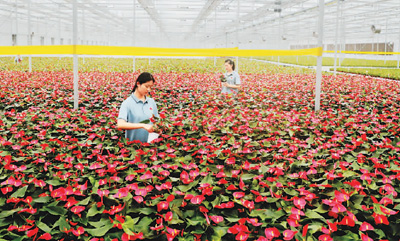China’s digital village construction spurs farmer’s productivity and happiness

Technicians check the growth of flamingo lilies at a modern agricultural industrial park in Dongying district, Dongying city, east China’s Shandong Province. (Photo/Liu Zhifeng)
Digital technologies such as big data, the Internet of Things (IoT), artificial intelligence, and cloud computing have been widely applied in people’s daily life in China’s rural areas, improving farmers’ daily life.
Zhong Yanping, a villager in Yongquan village, Dayi county, Chengdu, capital of southwest China’s Sichuan Province, often checks the growth of late-season rice in her paddy fields using an app on her smartphone.
She also receives alerts whenever pests and crop diseases are identified in her paddy fields, allowing her to take immediate action to control pests and diseases according to the app’s navigation services.
Zhong introduced that the app is connected to IoT-based cameras installed in the paddy fields. “Soil conditions, air humidity, temperature, and other indicators are sent to the digital agricultural platform of Dayi county, and technicians will then guide us according to the data,” she said, adding that she can also book a drone via the platform to sow seeds and apply fertilizers. Like Zhong, many farmers are freed from high-intensity manual labor thanks to smartphones.
Dayi county was included as one of 100-plus counties and districts for China’s pilot project of digital villages in 2020. These areas have made remarkable achievements in developing digital agriculture, with new technologies such as the IoT being applied in all stages of production, from plowing and sowing, to field management and harvesting.
Buji town in Jinxiang county, east China’s Shandong Province has integrated rural e-commerce and express delivery systems to boost the sales of garlic, noticeably enhancing the life of garlic farmers.
“E-commerce facilitates the circulation of agricultural products, helps stabilize purchase prices, and increases farmers’ incomes,” said Chen Wenkang, deputy head of the town.
Chen added that e-commerce also helps surplus rural laborers find jobs and retains a large number of young people in rural areas, who can often take better care of their family members.
China has given priority to building digital villages ever since 2018, when the country put forward a digital countryside strategy in a guideline on rural vitalization.
Since then, it has issued a package of policies on building digital villages, including an action plan to advance the construction of digital countrysides between 2022 and 2025.
The country’s administrative villages had all been connected to broadband Internet services, while 57.6 percent of the people living in rural areas had access to the Internet, said a report released by the China Internet Network Information Center in February of this year.
By the end of 2020, over 98 percent of China’s administrative villages had access to 4G networks and rural and urban areas of the country had enjoyed equally fast Internet, according to the Ministry of Agriculture and Rural Affairs.
Thanks to the continuous improvements in information infrastructure in rural areas, public services including medical insurance, social security and health care, as well as government services, have been made available online for rural residents, ensuring a more comfortable life for them.
China’s Internet plus government services model enables matters to be processed online for 492,000 villagers’ committees, efficiently improving rural governance, said Li Daoliang, a professor with the College of Information and Electrical Engineering of China Agricultural University.
Digitalization ensures access to high-quality public services in rural areas as much as possible and improves farmers’ quality of life, pointed out Huo Peng, an associate researcher from the China Academy of Information and Communications Technology.
Photos
Related Stories
Copyright © 2022 People's Daily Online. All Rights Reserved.









